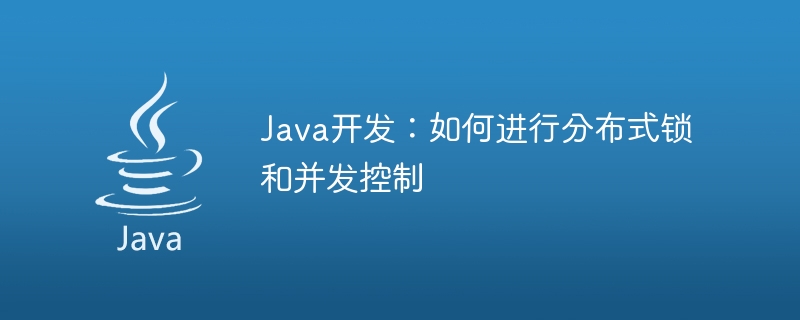

Java development: How to perform distributed locking and concurrency control, specific code examples are required
Introduction:
In a distributed system, multiple nodes can simultaneously Accessing shared resources requires concurrency control to avoid data consistency issues. In this article, we will introduce how to use distributed locks for concurrency control and provide specific Java code examples.
1. Introduction to distributed locks:
Distributed locks are a mechanism used to control concurrent access. It ensures that only one node can obtain the lock and perform operations on multiple nodes. , other nodes need to wait or perform other operations. This can avoid data inconsistency problems caused by multiple nodes concurrently accessing shared resources.
2. Ways to implement distributed locks:
3. Code examples:
We take Redis-based distributed locks as an example and provide the following Java code examples:
First, you need to introduce jedis dependency, as shown below:
<dependency> <groupId>redis.clients</groupId> <artifactId>jedis</artifactId> <version>3.5.3</version> </dependency>
Then, we can create a RedisLockUtil tool class to implement the logic of acquiring and releasing distributed locks. The specific code is as follows:
import redis.clients.jedis.Jedis;
import redis.clients.jedis.params.SetParams;
public class RedisLockUtil {
private static final String LOCK_KEY = "distributed_lock";
private static final String LOCK_VALUE = "locked";
private Jedis jedis;
private String lockId;
public RedisLockUtil() {
jedis = new Jedis("localhost");
}
public boolean lock() {
SetParams params = new SetParams().nx().ex(10); // 设置锁的超时时间为10秒
String result = jedis.set(LOCK_KEY, LOCK_VALUE, params);
if ("OK".equals(result)) {
lockId = LOCK_VALUE;
return true;
}
return false;
}
public boolean unlock() {
if (lockId.equals(jedis.get(LOCK_KEY))) {
jedis.del(LOCK_KEY);
return true;
}
return false;
}
}Next, we can use the RedisLockUtil class to implement distribution The acquisition and release operations of locks are as follows:
public class Main {
public static void main(String[] args) {
RedisLockUtil lockUtil = new RedisLockUtil();
if (lockUtil.lock()) {
try {
// 获取到锁,执行操作
System.out.println("执行操作");
} finally {
lockUtil.unlock(); // 释放锁
}
} else {
// 未获取到锁,执行其他操作
System.out.println("执行其他操作");
}
}
}Through the above code example, we can achieve the operation of acquiring and releasing distributed locks in a distributed environment.
Conclusion:
Distributed lock is an important technology and plays a vital role in the development of distributed systems. This article introduces the concept and implementation of distributed locks, and provides specific code examples based on Redis. I hope that by reading this article, readers can understand and use distributed locks for concurrency control, thereby improving the performance and data consistency of distributed systems.
The above is the detailed content of Java development: how to perform distributed locks and concurrency control. For more information, please follow other related articles on the PHP Chinese website!
 How to solve Java stack overflow exception
How to solve Java stack overflow exception
 es6 new features
es6 new features
 Laptop sound card driver
Laptop sound card driver
 How many types of usb interfaces are there?
How many types of usb interfaces are there?
 The installer cannot create a new system partition solution
The installer cannot create a new system partition solution
 A collection of common computer commands
A collection of common computer commands
 How to use unlocker
How to use unlocker
 vs2010 key
vs2010 key
 How to solve the problem that scanf return value is ignored
How to solve the problem that scanf return value is ignored




